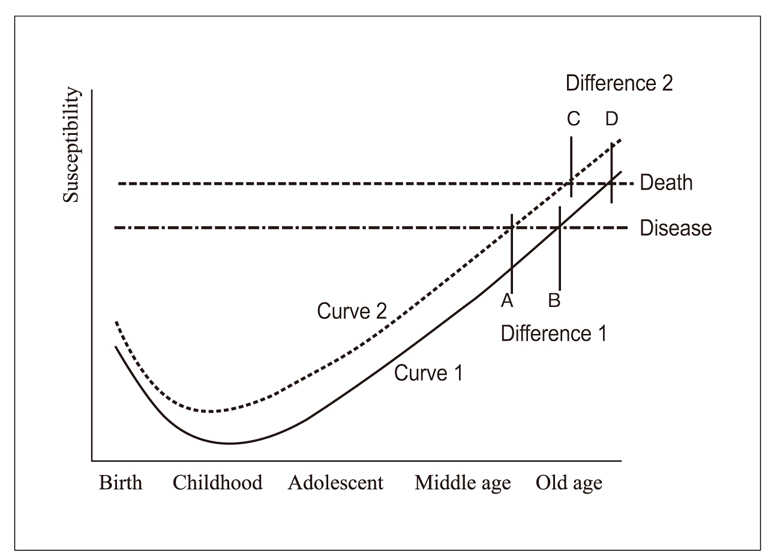 |
 |
- Search
| J Korean Med Assoc > Volume 50(2); 2007 > Article |
Abstract
Alot of studies on the associations between outdoor air pollution and effects on both acute and chronic mortality and hospital admissions have been published worldwide. The elderly population seems to be at a higher mortality and morbidity risk for air pollution. Time series studies based on Korean population show that elderly population are at higher risk of death due to nitrogen dioxide and Asian dust events. A study of daily hospital admission in Seoul shows that for ischemic heart disease the relative risk of admission associated with particle in the population aged 65 and more is two times higher that of younger population. APHEA (Air pollution on health; a European approach) projects show the similar trend of increased risk in elderly population. The effects of daily ambient particle concentrations on the number of deaths among the elderly in 28 European cities are consistently larger, by 10~20%, than those estimated for all age mortality. The mechanisms for the adverse health effects of air pollution have yet to be elucidated. A possible explanation is that air pollution adds the extra vulnerability which leads to increased risk of disease and morbidity. Regarding the fact that the proportion of elderly population has rapidly increased in Korea, we need to urgently lower the air pollution levels enough to protect the most sensitive populations including the elderly people.
References
1. Kwon HJ, Cho SH, Nyberg F, Pershagen G. Effects of ambient air pollution on daily mortality in a cohort of patients with congestive heart failure. Epidemiology 2001;12:413-419.
2. Kwon HJ, Cho SH, Chun Y, Lagarde F, Pershagen G. Effects of the Asian dust events on daily mortality in Seoul, Korea. Environ Res 2002;90:1-5.
3. Lee JT, Kim H, Cho YS, Hong YC, Ha EH, Park H. Air pollution and hospital admissions for ischemic heart diseases among individuals 64+ years of age residing in Seoul, Korea. Arch Environ Health 2003;58:617-623.
4. Aga E, Samoli E, Touloumi G, Anderson HR, Cadum E, Forsberg B, Goodman P, Goren A, Kotesovec F, Kriz B, Macarol-Hiti M, Medina S, Paldy A, Schindler C, Sunyer J, Tittanen P, Wojtyniak B, Zmirou D, Schwartz J, Katsouyanni K. Short-term effects of ambient particles on mortality in the elderly: results from 28 cities in the APHEA2 project. Eur Respir J 2003;40:S. 28-33.
5. Le Tertre A, Medina S, Samoli E, Forsberg B, Michelozzi P, Boumghar A, Vonk JM, Bellini A, Atkinson R, Ayres JG, Sunyer J, Schwartz J, Katsouyanni K. Short-term effects of particulate air pollution on cardiovascular diseases in eight European cities. J Epidemiol Community Health 2002;56:773-779.
6. Barnett AG, Williams GM, Schwartz J, Best TL, Neller AH, Petroeschevsky AL, Simpson RW. The effects of air pollution on hospitalizations for cardiovascular disease in elderly people in Australian and New Zealand cities. Environ Health Perspect 2006;114:1018-1023.
7. Anderson HR, Atkinson RW, Bremner SA, Marston L. Particulate air pollution and hospital admissions for cardiorespiratory diseases: are the elderly at greater risk? Eur Respir J 2003;40:S. 39-46.
8. Kelly FJ, Dunster C, Mudway I. Air pollution and the elderly: oxidant/antioxidant issues worth consideration. Eur Respir J 2003;40:S. 70-75.
Figure 1
Comparison by age of the increased risk of death associated with an interquartile increment of nitrogen dioxide in Seoul

Figure 2
A conceptual model showing how the added effect of air pollution could bring forward the onset of clinical disease and death
Adapted from Anderson HR, et al.(7)

Table 1
Estimates for the percent increase of the admission with ischemic heart disease.

Adapted from Lee JT, et al.(3)
Table 2
Estimates for the increase in the total daily number of deaths and deaths among the elderly associated with a 10µg/m3 increase of PM10

Adapted from Aga E, et al.(4)
Table 3
Pooled percentage increases under fixed and random effect models for a 10µg/m3 increase of PM10

Adapted from Tertre A, et al.(5)
- TOOLS
-
METRICS

-
- 1 Crossref
- Scopus
- 1,260 View
- 6 Download
-
Related articles in
J Korean Med Assoc -
Drug Therapy in the Elderly and Special Attention1998 May;41(5)
Appropriate Pharmacotherapy in Elderly Patients2005 January;48(1)
Respiratory Disease in the Elderly2005 February;48(2)





